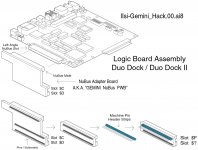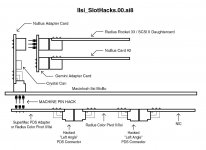Trash80toHP_Mini
NIGHT STALKER
. . . is a notion I've been sittin' on ever since I finally got the IIsi. It seems that the Gemini Two Slot adapter for the DuoDock is hackable so that the "Upper Slot" in the Duo can be hacked onto the connector or thru-holes for the IIsi's NuBus Adapter Card.
This will entail hard wiring the HDD's Power Cable to get the MoBo pins & shroud out of the way, and maybe a couple of other minor hacks. to the IIsi MoBo.
From the Gemini side of things, the EuroDin Connector to the DuoDock MoBo will need to be desoldered for it to fit due to space limitations in the IIsi, unless the entire bottom portion (a passive straight signal passthrough slot expansion card similar to the PCI adapters for the 5XXX & 6XXX PCI risers) can be lopped off entirely. Machine pins will need to be soldered, socket side down, onto the soldertails of the Gemini's "outer" NuBus connector so the pins will insert into the NuBus Adapter's female sockets.
From the NuBus Expansion Adapter end of things, the only thing I can think of would be removing the digital glue that assigns the Slot ID from the card and possibly replacing the EuroDIN connector with machine pins as sockets to mate with the machine pins soldered socket side down to the underside of the Gemini Card's Outer NuBus connector (as mentioned above) in order to shorten the distance between the sandwiched adapter pair.
The length of the lower card will depend upon the height/form factor of the HDD installed in theIIsi, unless of course I move that, along with the speaker, to the empty space under the FDD that's currently under consideration for a ZIP or DVD installation.
The hardest part of this silly lil' project will actually be modifying the @$$ end of the IIsi with a two (or, preferably, three) slot backplane offset from the existing slot. The third (bottom) of the slots would be used for breaking out the IIsiCrawlspaceCardsHack™ connectors to the outside world.
IIsiCrawlspaceCardsHack™ thread to be posted later. }
This will entail hard wiring the HDD's Power Cable to get the MoBo pins & shroud out of the way, and maybe a couple of other minor hacks. to the IIsi MoBo.
From the Gemini side of things, the EuroDin Connector to the DuoDock MoBo will need to be desoldered for it to fit due to space limitations in the IIsi, unless the entire bottom portion (a passive straight signal passthrough slot expansion card similar to the PCI adapters for the 5XXX & 6XXX PCI risers) can be lopped off entirely. Machine pins will need to be soldered, socket side down, onto the soldertails of the Gemini's "outer" NuBus connector so the pins will insert into the NuBus Adapter's female sockets.
From the NuBus Expansion Adapter end of things, the only thing I can think of would be removing the digital glue that assigns the Slot ID from the card and possibly replacing the EuroDIN connector with machine pins as sockets to mate with the machine pins soldered socket side down to the underside of the Gemini Card's Outer NuBus connector (as mentioned above) in order to shorten the distance between the sandwiched adapter pair.
The length of the lower card will depend upon the height/form factor of the HDD installed in theIIsi, unless of course I move that, along with the speaker, to the empty space under the FDD that's currently under consideration for a ZIP or DVD installation.
The hardest part of this silly lil' project will actually be modifying the @$$ end of the IIsi with a two (or, preferably, three) slot backplane offset from the existing slot. The third (bottom) of the slots would be used for breaking out the IIsiCrawlspaceCardsHack™ connectors to the outside world.
IIsiCrawlspaceCardsHack™ thread to be posted later. }



